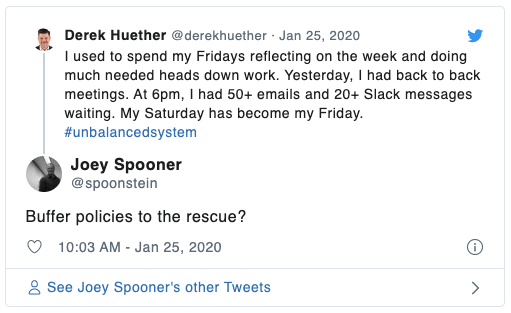I used to spend my Fridays reflecting on the week and doing much needed heads-down work. This Friday, I had back-to-back meetings. At 6pm, I had 50+ emails and 20+ Slack messages waiting. My Saturday become my Friday.
Feeling the need to vent, I took to Twitter:
Joey Spooner replied about buffer policies. My thought? This is exactly what I need!
Don’t know what a buffer policy is?
A lean manufacturing system is one that meets high throughput or service demands with very little inventory. Despite its significant success, Kanban control (visual indicators) is not a perfect mechanism to control a lean system. Kanban control uses the levels of buffer inventories in the system to regulate production. When a buffer reaches its preset maximum level, the upstream machine (or system) is told to stop producing that part type (or whatever it produces).
Remember back in the day when you would call someone on the telephone and a recording would inform you their voice mailbox was full? That is a buffer policy. The problem with current communication systems like email and chat is there is no maximum level. It’s unlimited. The system does not reject the communication, informing the upstream person that it will not accept their message. You can certainly turn an OOO responder on, and the communications may slow, but nothing stops the influx of new messages.
I would pay for a feature in Slack or Gmail that would reject incoming messages while informing the sender that I’m overloaded and I have reached my preset maximum level. How do you control the flow of emails or texts that you get? Do you do anything or just accept them?
